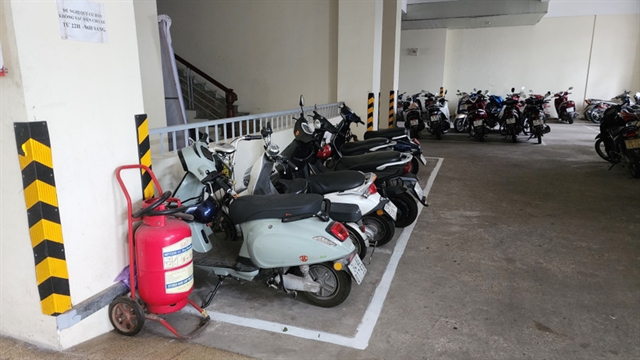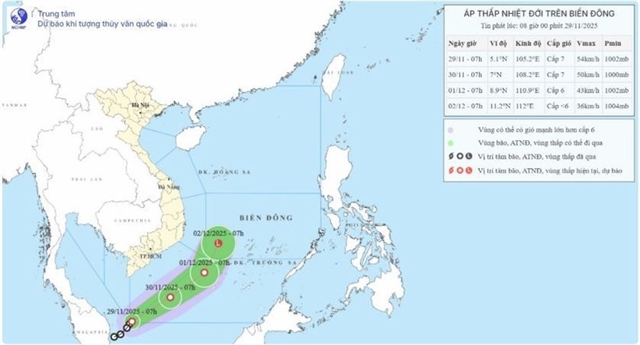 Society
Society

 |
| A designated charging area for electric motorbikes at an apartment building in Hà Nội. VNA/VNS Photo Việt Hùng |
HÀ NỘI — As Hà Nội prepares to ban gasoline motorbikes inside Ring Road 1 from July 1, 2026, the city faces a power challenge: its ageing apartment blocks and residential areas have power supply lines and substations that cannot handle the additional load from large electric vehicle charging stations.
The Department of Construction has urged the city to finalise support policies for residents switching to electric vehicles, expand public transport and carefully plan the locations of charging stations alongside upgrading infrastructure and grid capacity to meet growing public demand.
Reviewing thousands of charging locations
The Hà Nội Bus Station JSC has worked with partners to install charging points at three bus terminals. Giáp Bát station operates 40 chargers as of June 10, Gia Lâm has 34 chargers operational from July 15, and Mỹ Đình station is expected to open charging points in the third quarter of 2025.
The city’s Transport Management and Operations Centre reviewed five transit hubs, identifying three with potential to host bus charging stations. Across Hà Nội’s 122 bus terminal points, several could accommodate chargers, including bus stations, urban parking lots, shopping centres, railway stations and airports.
The Technical Infrastructure Centre identified 19 potential sites in public parks and parking lots, both underground and surface level. Meanwhile, the Hà Nội Housing Management Centre found space for 81 car chargers and 105 motorbike chargers at resettlement housing complexes, student dormitories, social housing and office clusters managed by the Department of Construction.
Private investors have also submitted proposals. TMT Co. seeks to pilot 500 locations across the city, including agencies, hospitals, universities, sidewalks and parking areas. Sài Đồng Urban Development JSC proposes a pilot project with 1,040 charging spots integrated with EV parking and green buffer zones at the Vinhomes Riverside Eco-urban area. V-Green Global Charging Development JSC has applied to install 106 chargers at on-street and sidewalk parking areas.
At the grassroots level, 59 out of 126 wards and communes have submitted land-use data for installing chargers. Within Ring Road 1, 115 sites have been identified; outside Ring Road 1, 386 sites are under consideration.
Legal and infrastructure bottlenecks
The Department of Construction highlighted several bottlenecks. Việt Nam currently lacks unified standards for EV charging stations, limiting interoperability across automakers and charging providers. There is also no comprehensive master plan for grid and charging infrastructure. Each project must undergo detailed surveys to assess capacity and technical feasibility.
Another challenge is land use, it said. Charging stations are classified as energy works, but there is no clear zoning category for them. If placed on agricultural or non-transport or commercial land, the site must go through a lengthy land-use conversion process. This complicates permitting, as construction approval under the Law on Construction requires consistency with land-use planning.
In old apartment blocks and existing residential areas, current electrical lines and substations cannot support additional high-load charging. This means Hà Nội must develop a phased plan for both station numbers and grid capacity upgrades.
The Department of Industry and Trade, which oversees the power grid and substations, has focused on supply-side infrastructure. However, without a detailed plan for demand and location, expanding charging facilities will remain difficult.
From fuel stations to charging hubs
To accelerate deployment, the Department of Construction proposes identifying inter-agency consensus sites for pilot stations that meet technical standards, support multiple connector types and serve a range of vehicles.
It says Hà Nội needs to establish standards for allowing petrol stations, shopping malls and commercial centres to install transformers, charging stations and battery-swapping points for clean-energy vehicles. Fire safety standards must also be developed for chargers and charging stations.
The city should revise its power grid and substation development plan to accommodate EV charging infrastructure, allowing flexible land-use arrangements to match clean-energy expansion.
Policy support will be critical, it adds, saying that proposals include subsidies for residents switching to electric vehicles, incentives for businesses investing in charging stations or manufacturing EVs and a roadmap to stop registering new gasoline motorbikes starting with Ring Road 1.
The department suggests the city gradually replaces existing petrol stations with charging and battery-swapping hubs, particularly inside and around Ring Road 1.
The city also needs to expand public transport within Ring Road 1 by adding small electric buses, building out public bicycle networks and offering electric bike and scooter rentals at transport hubs and parking facilities.
A traffic control scheme for vehicles entering Ring Road 1 is expected to be finalised by the first quarter of 2026.
In response, Hà Nội’s People’s Council Vice Chairman Nguyễn Mạnh Quyền instructed the Department of Construction to study the development of battery-swapping stations for electric vehicles, particularly in areas with high demand but insufficient conditions for installing charging points.
The power sector was tasked with working closely with relevant departments and agencies to design an overall power supply plan for the network of stations.
The Department of Construction was also assigned to pilot several charging stations at suitable locations, with the requirement that investors fully comply with all state procedures, standards and regulations.— VNS




